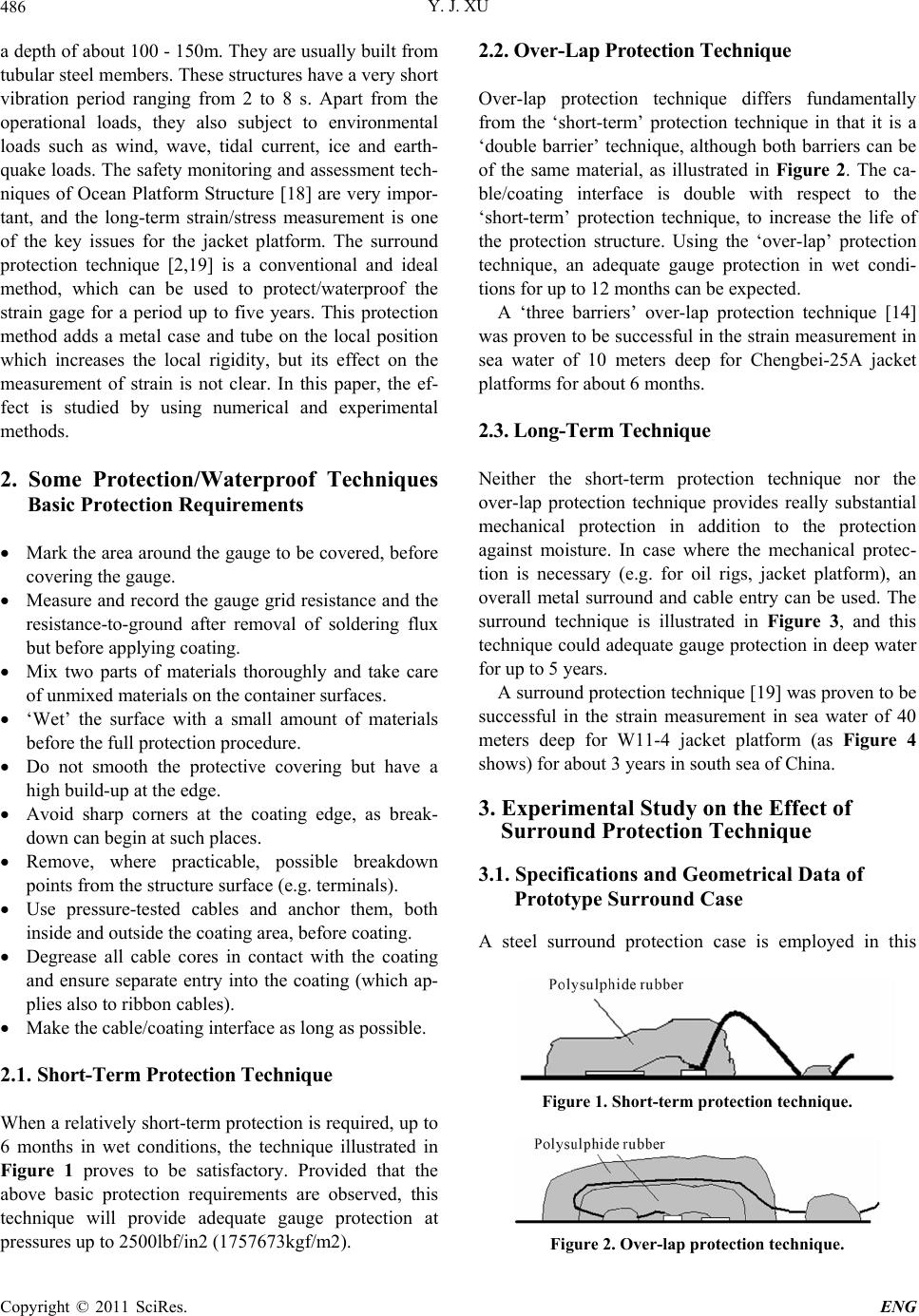
Y. J. XU
486
a depth of about 100 - 150m. They are usually built from
tubular steel members. These structures have a very short
vibration period ranging from 2 to 8 s. Apart from the
operational loads, they also subject to environmental
loads such as wind, wave, tidal current, ice and earth-
quake loads. The safety monitoring and assessment tech-
niques of Ocean Platform Structure [18] are very impor-
tant, and the long-term strain/stress measurement is one
of the key issues for the jacket platform. The surround
protection technique [2,19] is a conventional and ideal
method, which can be used to protect/waterproof the
strain gage for a period up to five years. This protection
method adds a metal case and tube on the local position
which increases the local rigidity, but its effect on the
measurement of strain is not clear. In this paper, the ef-
fect is studied by using numerical and experimental
methods.
2. Some Protection/Waterproof Techniques
Basic Protection Requirements
Mark the area around the gauge to be covered, before
covering the gauge.
Measure and record the gauge grid resistance and the
resistance-to-ground after removal of soldering flux
but before applying coating.
Mix two parts of materials thoroughly and take care
of unmixed materials on the container surfaces.
‘Wet’ the surface with a small amount of materials
before the full protection procedure.
Do not smooth the protective covering but have a
high build-up at the edge.
Avoid sharp corners at the coating edge, as break-
down can begin at such places.
Remove, where practicable, possible breakdown
points from the structure surface (e.g. terminals).
Use pressure-tested cables and anchor them, both
inside and outside the coating area, before coating.
Degrease all cable cores in contact with the coating
and ensure separate entry into the coating (which ap-
plies also to ribbon cables).
Make the cable/coating interface as long as possible.
2.1. Short-Term Protection Technique
When a relatively short-term protection is required, up to
6 months in wet conditions, the technique illustrated in
Figure 1 proves to be satisfactory. Provided that the
above basic protection requirements are observed, this
technique will provide adequate gauge protection at
pressures up to 2500lbf/in2 (1757673kgf/m2).
2.2. Over-Lap Pr otecti on Tec hnique
Over-lap protection technique differs fundamentally
from the ‘short-term’ protection technique in that it is a
‘double barrier’ technique, although both barriers can be
of the same material, as illustrated in Figure 2. The ca-
ble/coating interface is double with respect to the
‘short-term’ protection technique, to increase the life of
the protection structure. Using the ‘over-lap’ protection
technique, an adequate gauge protection in wet condi-
tions for up to 12 months can be expected.
A ‘three barriers’ over-lap protection technique [14]
was proven to be successful in the strain measurement in
sea water of 10 meters deep for Chengbei-25A jacket
platforms for about 6 months.
2.3. Long-Term Technique
Neither the short-term protection technique nor the
over-lap protection technique provides really substantial
mechanical protection in addition to the protection
against moisture. In case where the mechanical protec-
tion is necessary (e.g. for oil rigs, jacket platform), an
overall metal surround and cable entry can be used. The
surround technique is illustrated in Figure 3, and this
technique could adequate gauge protection in deep water
for up to 5 years.
A surround protection technique [19] was proven to be
successful in the strain measurement in sea water of 40
meters deep for W11-4 jacket platform (as Figure 4
shows) for about 3 years in south sea of China.
3. Experimental Study on the Effect of
Surround Protection Technique
3.1. Specifications and Geometrical Data of
Prototype Surround Case
A steel surround protection case is employed in this
Figure 1. Short-term pr ote c tion tec hnique .
Figure 2. Over-lap protection tec hnique .
Copyright © 2011 SciRes. ENG